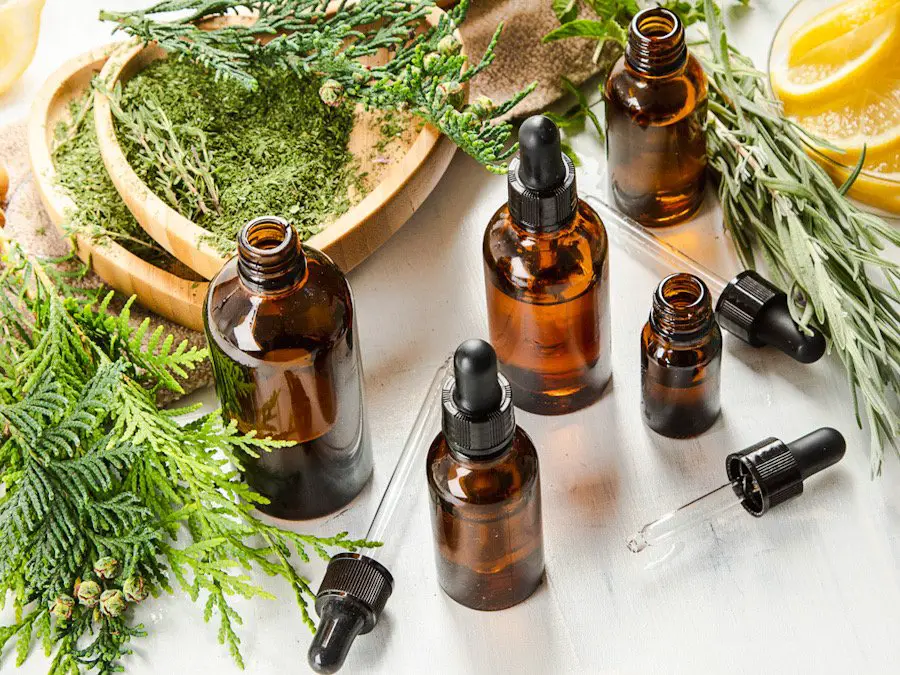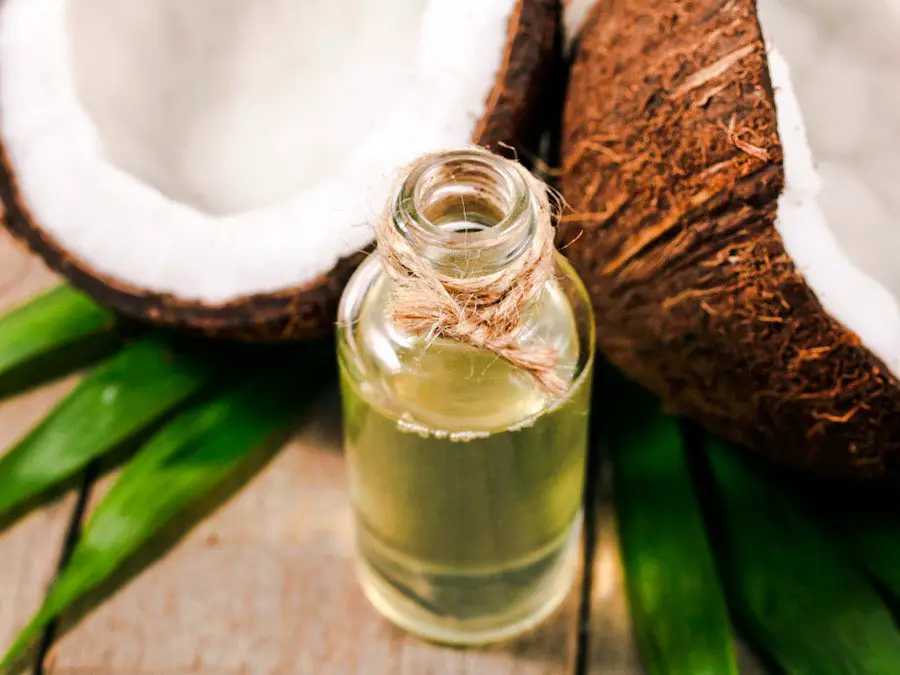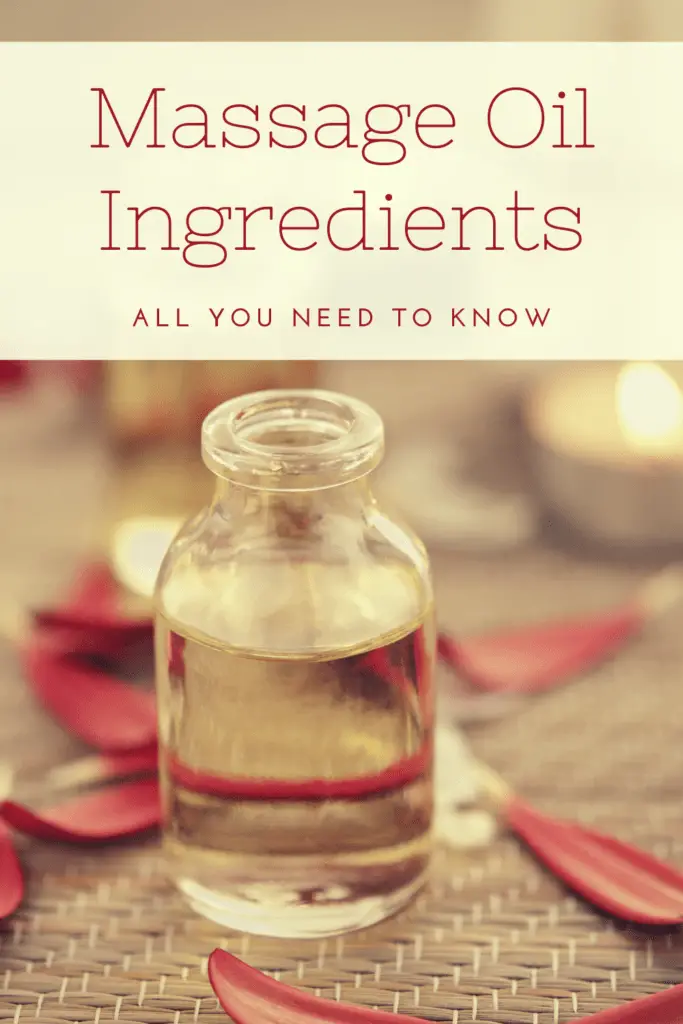If you’ve ever looked at a massage oil ingredient list, it may seem like a lot is happening in there. However, once you understand more about the types of massage oils and how they’re made, you’ll have a new understanding of how to read those ingredient lists and choose the best ones for your needs. What are the main ingredients in massage oils?
Most massage oils consist of one or more carrier oils mixed with essential oils. Carrier oils, like almond or fractionated coconut oil, make up most of the massage oil and are responsible for allowing hands to glide over the skin during a massage. They also blend well with other ingredients. The added essential oils, like lavender, sandalwood, or rosemary oil, provide fragrance and the benefits of aromatherapy.
While you always want to read the massage oil ingredient list, most massage oils are going to stick to simple and natural products. Companies know that this is one of the reasons people choose massage oil over other options in the first place.
In this article, we’ll take a deeper look at what massage oils are made of, what types of qualities you will want to take into consideration as you choose the best one for you, and how you might make a massage oil blend all your own for home use.
Table of Contents
What Are Massage Oils Made Of?
When you buy commercial massage oils, you’re mostly going to find them with one or two carrier oils and then a mix of essential oils.
The ingredients list may look a lot more intimidating than that. It can seem like they have ten or fifteen ingredients in there. However, once you recognize the names of the most common carrier oils, you can start to understand that the first ingredient is your main massage oil and then the following items in the list are typically essential oils added in for extra benefits and fragrance.
There are some massage oils that attempt to get more creative with this. They may combine three oils, like sunflower oil, rice oil, and coconut oil, and then add in a handful of essential oils. These are still the two main types of ingredients you’re going to see. Typically, they will use the more scientific names, and then put the common names in parentheses to make this more identifiable.
The more ingredients you see in a massage oil you can buy at the store for home use, the less likely it is that a massage therapist would ever choose that oil.

Most massage therapists will either just use a carrier oil on its own, blend this with an essential oil of their choice, or purchase a massage oil made with the simple two-ingredient structure.
One of the main reasons that massage therapists choose oil over lotion, creams, or gels is the simple ingredient list. While there are other benefits to massage oils, like the glide of the liquid, applying synthetic ingredients to their clients and themselves day in and day out becomes a genuine concern for many massage therapists.
Many of the common massage oils you may see will include fractionated coconut oil, almond oil, grapeseed oil, apricot kernel oil, jojoba oil, olive oil, sesame oil, wheat germ oil, and sunflower oil.
If you are interested in the benefits massage oils can bring to your skin, check out our article ‘Is Massage Oil Good for Your Skin? All You Need to Know.’
Some Examples of Massage Oil Ingredient Lists
Let’s take a look at some sample massage oil ingredient lists from popular store-bought options. This will give you an eye for what’s out there.
One of the most luxurious and popular massage oils is the Elemis brand De-Stress Massage oil. Their ingredient list is actually quite long. If you read through it, you’ll see that it’s sweet almond oil (a carrier oil), combined with a long list of essential oils like rosewood, grapefruit, rosemary, marjoram, and chamomile.
In another example, goop has combined two carrier oils with several essential oils. They combined fractionated coconut oil and sunflower seed oil, infused it with vitamin E, and added in rosemary leaf extract, cedarwood, jasmine, cardamon, and others.
At a lower price point, the Majestic Pure brand has a massage oil for targeting sore muscles. Their carrier oil is sweet almond oil, and then they add in chamomile, grapefruit, and lavender among their essential oils.
Once you recognize that there are carrier oils and then essential oils, the ingredient lists are a bit easier to understand.
Considerations When Choosing Massage Oil Ingredients
To begin with, let’s be clear that all massage oils are not the same.
While everyone will have their own unique concerns, there are a few things everyone wants to consider when choosing massage oil ingredients.

When a massage therapist is choosing a massage oil, they’re doing so in a way that is going to please as many of their clients as possible. When you’re choosing one for yourself, you have the benefit of choosing one that fits your unique needs.
Your unique needs likely begin with your skin type. Do you have oily skin? If you are prone to breakouts, you’ll want to be more cautious about the massage oil ingredients you choose. Almond oil may be too much for your skin and lead to breakouts. Something like jojoba oil will be lighter and much easier for people with oily skin. If you have dry skin, avocado oil has been known to be great for moisturizing.
Do you have any allergies? Today, it’s easier to find nut-free massage oils, but you’ll need to be cautious about what you choose. Some people may have reactions to coconut oil, and latex allergies have been known to cause reactions with many different types of oils. Make sure you know your health concerns before choosing ingredients.
Keep in mind that if your massage oil has added essential oils, or you decide to add in essential oil, this is also a concern for allergies!
How do you feel about fragrance? A lot of people like to choose a carrier oil that has a neutral scent. Then, if they want to add a scent, they can use essential oils for fragrance. This has the bonus that if you wish to enjoy a lemon scent today but sandalwood next month. If you’re buying a massage oil packed with essential oils in the ingredient list, there will definitely be a scent.
Where are you going to be using your massage oil? Are you worried about staining your sheets? This is a pretty serious consideration, actually. A lot of popular massage oils, like almond oil, will be pretty rough on your sheets. Fractionated coconut oil doesn’t stain as much. If your sheets are dark in color and made of synthetic fabric, they’ll be more prone to staining. If you are worried about staining your sheets, check out our article ‘Which Massage Oil Won’t Stain My Sheets?’.
The consistency of the massage oil will vary considerably by ingredients. Do you want a lot of glide in your massage oil? Are you looking for a deep tissue massage? Do you want your hands to slip over the surface of the skin for long strokes? Know what kind of experience you want and the consistency of the oil before making a choice.

Shelf life is something worth thinking about. Sunflower oil is a great, light substance that won’t leave your skin feeling greasy. However, it goes rancid fairly quickly. You need to use the bottle up right away after you open it. Meanwhile, grapeseed oil and jojoba oil have a long shelf life.
The last consideration is the price. This actually varies quite a lot depending on the massage oil’s ingredients. More expensive doesn’t actually guarantee a “better” experience, which is why it’s the last consideration on this list. You can buy an inexpensive oil that turns out to be your favorite and an expensive one that leads to breakouts. Pricing for massage oils is primarily about the ingredients and how expensive they are. Certainly, stick to your budget, and keep in mind that your favorite item may be more expensive, but it may also be the least.
Choosing a Massage Oil At the Store
So now we understand the ingredient list can be split into two sections. First, there’s the carrier oil. There may be more than one of these. And then there are all the essential oils added in.

When choosing a massage oil, you’ll want to look at the carrier oil(s) first. Do you like fractionated coconut oil? Are you in love with sweet almond oil? Do you need to find jojoba oil? This will narrow down your selections considerably.
Then, look at the essential oils. Consider things like your allergies and fragrances. Then consider what you find relaxing. For example, chamomile and lavender may be good essential oils to look for when you want a relaxing massage at home.
What are some carrier oils you might want to look for?
Jojoba Oil
This is a popular choice and is on many top ten lists. Jojoba oil has antibacterial and anti-inflammatory properties. It is also light and doesn’t clog pores. All of these properties make it one of the better choices for a person who has oily skin.

It also has a neutral scent, won’t stain the sheets, and is an effective carrier oil, meaning it mixes well with essential oils. It also has a long shelf life.
This oil does tend to be pricier than some of your other options.
Sweet Almond Oil
This one is full of vitamin E and essential fatty acids. That makes this a great choice for someone with dry skin looking to moisturize.

It’s more oily than something like jojoba or sunflower oil. That means it provides a lot more glide. It absorbs into the skin fairly quickly but not so quickly that you have to reapply it overly often.
It’s a touch less expensive than jojoba oil.
It is a pale yellow color and is prone to staining sheets.
This is almond oil, so this is not for people with a nut allergy!
Fractionated Coconut Oil
Note the word fractionated. That means this is not the coconut oil you cook with. The long-chain triglycerides were removed from this coconut oil, giving it a different, softer texture.

It is lightweight. It has a neutral scent. Note that means it does not smell like coconut. It has a long shelf life. Fractionated coconut oil is often less expensive.
It’s a slightly stickier oil, so it has less glide. This can make it well-suited to deep tissue massages. It also makes it not greasy, which a lot of people like.
People with coconut allergies, or latex allergies, should likely avoid fractionated coconut oil for massages!
Other Carrier Oils
Sunflower oil is a light and non-greasy option, though it has a short shelf life.
Avocado oil is often a touch pricy, and likely not a good option for people with oily skin. However, for people with dry skin, it’s a great moisturizer.
Kukui Nut Oil is lightweight. This oil is from Hawaii and is often a touch more expensive. It has a neutral scent, a long shelf life, and is great for all skin types.
Grapeseed oil is a bit of a troublemaker if you are worried about staining your sheets, so beware. Despite this, it’s still a popular option as a silky massage oil that is good for sensitive skin and acne-prone skin. If you want to know more about this option, check out our article ‘Relaxing Massage with Grapeseed Oil. Is It a Good Idea?.’
Mixing Your Own Massage Oils At Home
Some people do not find mixing their own massage oils to be relaxing. If that’s you, there is no shame in buying straight massage oil with one ingredient or buying a premade blend. This is something you’re doing for yourself to relax, so do it however you get the most benefits from it.

Others just love blending their own massage oils, and that’s great, too! For them, mixing their own massage oils at home is part of the relaxing experience. If you think that may be you, then let’s go ahead and look at how you can do that. Luckily, it’s easy. It also means you’ll never have to ask “What is this massage oil made of?” because you’ll have made your own.
Supplies For Making Your Own Massage Oil
First, you need your carrier oil. We’ve gone over some properties of those up above. Choose the one that suits your needs best. You don’t need a large bottle to get started. You could do your first massage with only an ounce of carrier oil. If you’re going to be buying a larger bottle, keep an eye on the shelf life.
Then you need any essential oils you want to add to the mix. You can add just one essential oil or a mix of several. This is all about your goals for your massage. Part of the fun of making your own massage oil is getting to choose the essential oils that best fit your desires and mood.
A bottle for storing and mixing your massage oil in. Generally, your massage oil will last longer if the glass is dark. You can use almost anything, but an amber glass bottle with a dropper is a popular choice. You can get a nice, inexpensive set on Amazon here.
A label of some kind. You will want this! You are unlikely to remember a month or two from now what you put in the bottle if you don’t label it. Trust me, this is a nice thing to have around.
Properly Mixing Your Massage Oil
Essential oils are not meant to be put directly on the skin. They are meant to be diluted with a carrier oil. Keep this very important rule in mind.
You need to follow guidelines for your essential oil dilution. The general rule is about 2% of your mixture can be essential oils for adults. That means you can have six teaspoons of carrier oil mixed with 15 drops of essential oil. That’s the total amount for essential oils. So if you want to use more than one essential oil, the total among all of them is still 15 drops.
All you need to do to combine and create your massage oil is put the correct amount in your final bottle, put on the lid, and shake well.
Remember This Important Rule
As a general rule, after you mix together your own massage oil, you need to do a patch test. Even if you don’t believe you have any allergies, you never know what could happen. If you’re going to put your massage oil all over your body, you don’t want to risk a reaction!
One of the best ways to do this is to put a drop inside your wrist. Put a bandage over the spot. Wait 24 hours and then check your wrist. If you’re good, then you’re good to go.
And do not forget: never put the essential oils directly on your skin. Only when diluted with a carrier oil in the appropriate amount.
Choosing Essential Oils For Your Own Massage Oil
Some essential oils you may look into include nutmeg oil, lavender oil, rosemary oil, chamomile oil, bergamot oil, peppermint oil, grapefruit oil, jasmine oil, sandalwood oil, vanilla oil, sweet orange, frankincense, geranium, carrot seed, rose absolute, spearmint, pine, ginger, tea tree oil, and lemon oil.
And those are just a few examples. The world of essential oils is large. Don’t let it overwhelm you.
If you’re just looking for a relaxing and calming massage, you might want to look into lavender oil, bergamot oil, and chamomile oil. You can split your essential oil drops evenly between these three and get a calming blend.
There is a lot to know about essential oils, but you don’t need to know every kind out there to create a nice experience for yourself. Know that there are calming essential oils, like lavender, and ones that make you more alert, like citrus oils. Choose what is best suited for your goals for your massage.
Moving Forward With The Best Massage Oil Ingredients

If you only take a few things away from this guide, keep these things in mind.
First, that your dilution for your essential oils and carrier oils is very important if you make your own massage oil at home.
Second, always do a patch test on your skin, even when you buy a massage oil from the store. Everyone’s skin is different, and you want to treat yourself with the respect you deserve. That’s one of the goals of giving yourself this massage experience, right?
And last, remember that there is no right way or wrong way to go about choosing your massage oil. The strategy here is to know yourself, and then choose oils that support your own needs.
Paying more does not necessarily mean better quality, since the quality will be defined by what is best for your skin.
If you have oily skin, look at carrier oils like fractionated coconut oil or jojoba oil.
If you have dry skin, look at sweet almond oil or avocado oil.
Try out the massage oil that sounds best to you. If you enjoy it, stick with it! If not, you can always try another. Fortunately, there are many great massage oil ingredients you can choose from, and now you know how to read the bottles.
You now know everything you need to know to choose the best massage oil ingredients for your needs. Now, it’s time to enjoy your massage!
If you would like to know how to properly care for your massage oils, check out my article ‘Can Massage Oils Expire? How Long Do They Last and How to Store Them.’


